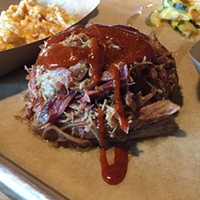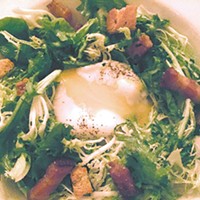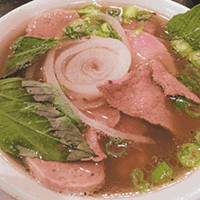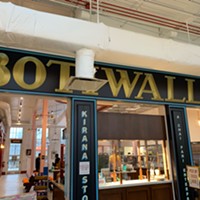At 7 p.m. the sun had not set and the restaurant owner glanced around her empty eatery, straightening a chair and smoothing the white tablecloth at a neighboring table. A few tourists stopped by to read the menu posted by the street but then strolled back to the beach. Hers is one of a dozen restaurants squeezed together along a promenade in the pricey seaside Spanish resort of Tossa de Mar on the Costa Brava, about 100 miles north of Barcelona and 30 miles south of Roses, the home to Ferran Adrià's El Bulli (which means bulldog, not bull) a three-Michelin star restaurant, and the epicenter for gastronomic pilgrims.
But Tossa is a beach town inhabited by European vacationers who are not looking for the world's best food, only good food served by the sea. By 9 p.m., the sun has still not set, but customers now populated the tables, ordering one of the house specialty paellas or a bevy of seafood starters: tender sliced octopus over boiled potatoes, fresh sardines wrapped around chopped peppers and mussels steamed in wine.
Tossa and Barcelona shared a common identity. Both are cities in Catalonia, a tiny (by American standards) nation located in the upper right hand corner of the Iberian peninsula, bordered by the Pyrenées and the Mediterranean. Last August Catalonia gained further autonomy from Spain by being recognized as having nation status. But both Spanish and Catalan flags fly over government buildings, and unlike the even smaller neighboring Principality of Andorra, Catalonia doesn't have its own license plate -- yet.
Catalan cuisine, however, has had its own distinctiveness for centuries. Since this nation has been one of those "also-conquered-by" Mediterranean states, the food has adapted elements from the cuisines of its invaders: Greek, Carthaginian (of Phoenician/Lebanese descent), Roman, Moor/Arab, Spanish and French.
Tapas are the food that makes Barcelona come alive, and the liveliest spot in Barcelona is Las Ramblas, once a busy boulevard, now overlaid with a large centered pedestrian mall (with underground parking). Off this street is the renown Mercat de Sant Josep, better known as the Boquería food market, which opens at 6 a.m. and has, in addition to food vendors, three tapas bars. Perhaps the best known of these is Pinotxo. But, the 10-seat El Quim in the middle of the market, has bar stools that turn over more quickly. The pa amb tomaquet (a Catalan bruschetta) made on crusty white bread is sensational, while sardines, bathed in olive oil and lemon, squid with eggs, and steamed mussels give a nod to the Mediterranean. More rustic is the morcilla (blood sausage) with beans and the tortilla (egg flan). Since the Penedes wine district is southwest of Barcelona, the residents, who are overwhelmingly localvores, have either a glass of cava (locally made sparkling wine) or a glass of beer with tapas.
Barcelona is filled with tapas bars. One of the best I found is Paco Meralgo alta Taberna, located in an affluent L'Eixample neighborhood. The seats are all high bar stools with small high tables. The best spot to grab (come before 9 p.m.) is around the two bars with their small glass sushi-like display case. The idea here is to see what you want and point. But the specials are also written (in Catalan) on a chalkboard, and full menus are offered in Spanish, Catalan, or English.
Of course we feel obligated to taste the raw sea snails -- a bit dicey but mainstream enough to preclude a clip with Andrew Zimmern. The scallops are three inches across and nearly as thick. Although the hot items come out of the kitchen, the cold tapas are produced at the bar. Serrano, a must have, is sliced paper thin in a machine that also grips the hoof of the ham.
On another night we ventured to Inopia, a newly opened tapas bar, owned by Albert Adrià (brother of Ferran, and pastry chef of El Bulli). Inopia is located far from the tourist areas; however, a recent write-up by cookbook author Mark Bittman in the New York Times added a sprinkling of New Yorkers to this 40-person eatery. Although the kitchen is open to the street, a bouncer keeps the crowd at bay. Once inside, I must admit, I felt pretty good -- until I realized only half the people are seated on high bar stools; the rest are standing and eating at the small counters lining the wall. Only one large 12-seat table exists, which held a celebratory party.
Inopia serves traditional tapas: no foams or molecular gastronomy here. This is strictly meat and potatoes: ham coquettes and patatas brava (thickly cut French fries with a spicy tomato sauce). The best, though, was their fried sardine sandwich served on still warm bread, but not garnished with a condiment. Only the fish. Yum.
Although French and Italian wines are on most of the menus we saw, the majority of tables selected Spanish wines, primarily glasses of cava, but bottles of red, and rosé, too.
With tapas the cuisine du jour here in the States, I was struck with the difficulty of serving truly authentic tapas unless located in a coastal city. Much of what the locals eat in Catalonia is home grown. But the other side is the preponderance of canned foods used in tapas. Some of these items -- anchovies, sardines, tuna -- are so expensive, grocery stores use protective cases to guard against theft. An interesting contrast, but one which is the heart of Catalan cuisine.
Have a restaurant tip, compliment, complaint? Do you know of a restaurant that has opened, closed, or should be reviewed? Does your restaurant or shop have news, menu changes, new additions to staff or building, upcoming cuisine or wine events? Note: We need events at least 12 days in advance. Fax information to Eaters' Digest: 704-944-3605, or leave voice mail: 704-522-8334, ext. 136.
Speaking of 2.20000
-

Bombs Bursting In Air
Jul 2, 2003 - More »
Latest in Food & Drink Features
More by Tricia Childress
-

Seoul Food Meat Co's got soul
May 4, 2016 -

Aix en Provence flourishes in Myers Park
Apr 6, 2016 -

Pho and beyond at Saigon Bay Vietnamese Cuisine
Mar 2, 2016 - More »
Calendar
-

Aria Tuscan Grill Featuring Allegrini - Charlotte Wine + Food Week @ Aria Tuscan Grill
-

Angeline’s Featuring Sciandri Family Vineyards @ Angeline's
-

Charlotte Wine + Food Week Presented by Truist @ Charlotte, NC
-

Cakeable Cafe Grand Opening @ Cakeable Cafe
-

Haw River Wine Tasting @ Carolina Beer Temple.
-
Dorie Greenspan's Tiramisu Cake
This layered cake is definitely a "pick-me-up" with a little booze and caffeine.
-
Authentic New York-style Bagels Come to South End 1
Poppy's expands its empire
-
Eating With Your Dollars: The best fast food money can buy 14
The Food Babe talks juicing.











